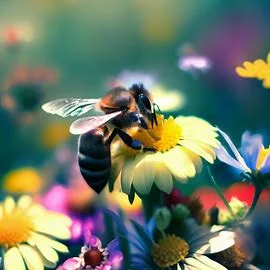Seed Bombing: The Explosive Impact of Guerrilla Gardening Seed Bombs
Discover the transformative power of guerrilla gardening with our comprehensive guide on seed bombing. Learn how to create and plant seed bombs, understand their impact on urban environments, and navigate the legal aspects of this green movement. Dive into the world of guerrilla gardening and see how these small seed bombs can create an explosive impact on your community.
What does Guerilla mean?
The Power of Seed Bombing
Seed bombing, a method popularized by guerrilla gardeners, is a unique and effective way to cultivate plants in neglected or hard-to-reach areas. This innovative approach to gardening involves the use of "seed bombs," small balls made of compost, clay, and seeds, which are then thrown or dropped into the desired area.
The Art of Guerrilla Gardening Seed Bombs
Guerrilla gardening seed bombs are a powerful tool in the arsenal of those who wish to bring life to barren or neglected spaces. These seed bombs are designed to protect the seeds from animals, insects, and other elements until they are ready to germinate. They are often used in urban environments, where access to soil may be limited, or in areas where traditional gardening methods are not feasible.
How to Plant a Seed Bomb
Planting a seed bomb is as simple as it sounds. First, you choose the area you want to cultivate. This could be a neglected plot of land, a barren cityscape, or even a hard-to-reach roadside verge. Once you've chosen your target, you simply throw or drop the seed bomb onto the area. The rain will gradually erode the clay and compost, allowing the seeds to take root in the soil beneath. Over time, these seeds will grow into plants, bringing a burst of greenery and life to previously barren spaces.
The Legality of Seed Bombing
One question that often arises when discussing guerrilla gardening and seed bombing is, "Is seed bombing illegal?" The answer to this question is complex and largely depends on the laws of the specific region. In some areas, guerrilla gardening and seed bombing may be considered illegal because it involves planting on land that the gardener does not own or have permission to cultivate. However, in many places, the practice is tolerated or even encouraged, especially when it is used to beautify neglected or abandoned spaces.
Before you embark on a seed bombing mission, it's important to research the laws in your area. While the intention is to bring life and beauty to neglected spaces, it's essential to ensure that your actions are within the bounds of the law.
Where is Guerilla Gardening Popular?
Guerrilla gardening is a global movement and has been reported in many cities around the world. Here are a few places where it's particularly popular:
- London, UK: The movement is very active in London, where the term "guerrilla gardening" was first coined. Richard Reynolds is a well-known guerrilla gardener based in London who has written a book on the subject and maintains a website to encourage others to take up the practice.
- Los Angeles, USA: Ron Finley, also known as the "Gangsta Gardener," has made headlines for his guerrilla gardening efforts in South Central LA. He's known for planting vegetable gardens in abandoned lots, traffic medians, and along curbs.
- Berlin, Germany: Guerrilla gardening is also popular in Berlin, where gardeners have taken over vacant lots and turned them into community gardens.
- Tokyo, Japan: In Tokyo, a group called Green Guerrillas has been active in creating pocket gardens in the city.
- Toronto, Canada: Toronto is home to several guerrilla gardening groups that plant in neglected spaces around the city.
Remember, guerrilla gardening is often an act of defiance against the neglect of public spaces, so it can happen anywhere there are people willing to take action.
What Plants Are Good for Guerrilla Gardening?
Choosing the right plants for guerrilla gardening depends on the specific conditions of the area you're planning to cultivate, including the climate, soil type, and amount of sunlight. However, here are some general suggestions:
- Sunflowers: These are hardy plants that grow well in a variety of conditions. They're also tall and bright, making them a good choice for making a visual impact.
- Marigolds: These flowers are tough and can survive in less-than-ideal soil conditions. They also have the added benefit of repelling certain pests.
- Nasturtiums: These are easy to grow from seed and can thrive in poor soil. They produce vibrant, colorful flowers.
- Poppies: Poppies are often used in guerrilla gardening because they're hardy and can grow in a variety of conditions. Plus, their bright flowers can make a big impact.
- Herbs: Many herbs, like rosemary, thyme, and mint, are quite hardy and can thrive in a variety of conditions. They also have the added benefit of being useful for cooking.
- Wildflowers: Wildflower mixes can be a good choice because they contain a variety of seeds that can grow in different conditions.
- Squash and Pumpkins: These plants are hardy and can cover a lot of ground, but they do need a fair amount of space to grow.
- Tomatoes: While a bit more delicate, tomatoes can be a rewarding choice for guerrilla gardening if the conditions are right.
Remember, the key to successful guerrilla gardening is choosing plants that are well-suited to the local environment and can thrive with minimal care.
Blooming Havens for Bees
Guerrilla gardening significantly benefits bees by providing essential food sources. The practice often involves planting wildflowers, herbs, and other nectar and pollen-rich plants. These guerrilla gardens act as mini refuges for bees, supplying diverse nutrients crucial for their survival.
Conclusion: The Impact of Seed Bombing
Seed bombing is more than just a gardening technique; it's a form of environmental activism. Through the simple act of throwing a seed bomb, individuals can contribute to the greening of their communities, the creation of habitats for local wildlife, and the beautification of their surroundings. So, whether you're an experienced guerrilla gardener or just someone who wants to make a difference in your local environment, consider the power of the seed bomb. It's a small tool, but it can have an explosive impact.


